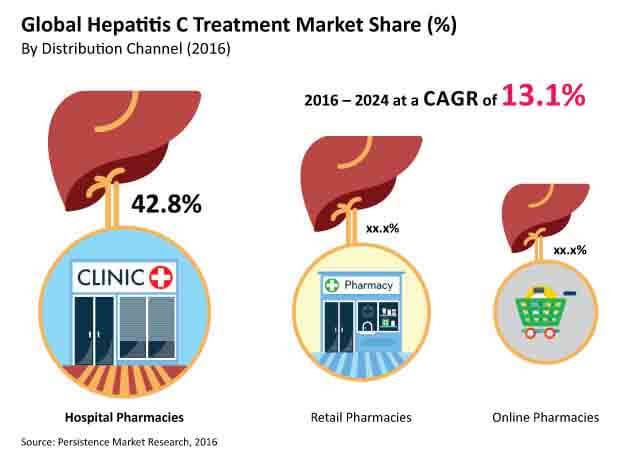Hepatitis C Treatment Market Segmented By Hepatitis C Drugs, HCV by HCV Protease Inhibitors, HCV Polymerase Inhibitors, HCV NS5A Inhibitors, Combination Therapy, Interferon and Antiviral Drug Class
Industry: Healthcare
Published Date: November-2016
Format: PPT*, PDF, EXCEL
Delivery Timelines: Contact Sales
Number of Pages: 168
Report ID: PMRREP3602
The global market for hepatitis C vaccine is progressing with the growing prevalence of hepatitis C infection amongst the demographics. The market is primarily driven by the participation of multiple companies in the development of treatment and medications. Initiatives such as subsidized drugs and funds allocation by governing authorities in different countries is contributing significantly to market expansion.
Awareness created by different NGOs and educated millennials is acting as a growth lever for the vaccine's landscape. Various factors such as the high cost of drugs and therapy is a major challenge in the market growth. Besides prices, the stringent regulatory norms are delaying advancements and arrivals of new products in the market, restraining its growth.
North America is estimated to the largest market for the hepatitis C vaccine with around 45% of the market share. Europe and the Asia Pacific are expected to gain prominence in the global market. Developing economies such as India and China have emerged as major markets owing to the presence of a large patient pool. Prominent players in the global market are Bristol-Myers Squibb Company, Merck & Co., Inc., F Hoffmann-La Roche Ltd, Gilead Sciences, Inc., Johnson & Johnson, Kadmon Holdings, Inc., and Merck & Co., Inc., Johnson & Johnson and AbbVie Inc.
Hepatitis C is a viral infection primarily affecting the liver with the hepatitis C virus. It often leads to cirrhosis and further cirrhosis may develop complications such as liver failure, liver cancer, or esophageal and gastric varices. Early stage of infection typically has no symptoms.
Critical stage of infection may display symptoms such as fever, dark urine, abdominal pain, and yellow tinged skin occurrence. People with alcoholism and HIV infection of any age group are at increased risk. Hepatitis C treatment market consists of drugs used for treatment of the disease.
The global hepatitis C treatment market is projected to be valued at US$ 23.9 Bn by the end of 2015 and is further expected to reach US$ 71.13 Bn by the end of 2024, registering a CAGR of 13.1% over the forecast period of 2016-2024.
Developing countries such as India, China and Brazil have a large patient pool compared to other developed countries. This increases demand for hepatitis C treatment drugs. Few countries and state governments have taken initiatives to control hepatitis C infection by subsidizing drugs or by giving special funds towards disease treatment programs. Various private NGOs create awareness and educate the population to help fight against the hepatitis C infection. These may also be considered as drivers for the Hepatitis C treatment market.
Prevalence of hepatitis C infection among the global populace is increasing. This is mainly caused by sharing needles, unsterilized medical equipment, and blood transfusion filter from infected mother to new born baby.
In hepatitis C infection treatment, there are around 2300 molecules in pipeline studies and around 300 in phase 4 studies. Various companies are getting involved in the development of hepatitis C treatment medication. This would lead to development of new products, which ultimately drives the market.
High cost of drugs is the top restraint for the market, as cost of the therapy is much higher and the general population cannot afford the treatment. For example, cost of Harvoni (Ledipasvir & Sofosbuvir) medicine is US$ 94,500 for 12 week treatment that is around US$ 1100 per pill. Stringent regulatory norms hinder early approvals and derail commercialization of products, which ultimately hampers market growth.
Different countries have different regulation bodies to approve the drugs for disease treatment. Due to this, drugs are not easily approved in the market, affecting the availability of products in the market. According to The United States Attorney General (A.G.) more than 50% doctors who prescribed Harvoni were denied coverage by their insurer. Insurance providers deny reimbursement requests due to high treatment cost. Moreover, payers reimburse very small amount of total cost of the treatment which ultimately reduces overall market size.
By drug class, the combination therapy segment accounted for about 66.2% share of the overall market value in 2015. By distribution channel, the hospital pharmacies segment is estimated to account for the highest market share of 42.8% of the global hepatitis C treatment market by 2016 end while the retail pharmacies segment is estimated to account for 34.2% market share in 2016.

The global hepatitis C treatment market was valued at US$ 23.9 Bn in 2015. North America was the largest market for hepatitis C treatment, accounting for over 45.6% revenue share of the overall market in 2015, followed by Europe with around 19.4% share. The Asia Pacific market is expected to exhibit the highest CAGR of 14.8% during the forecast period (2016–2024), followed by Latin America.
Key players of the global hepatitis C treatment market include AbbVie Inc., Bristol-Myers Squibb Company, F Hoffmann-La Roche Ltd, Gilead Sciences, Inc., Johnson & Johnson, Kadmon Holdings, Inc. and Merck & Co., Inc.
The market is consolidated with a few key players in which Gilead Sciences, Inc. contributes around 80.1% of the market share, generating majority of the revenue from the sales of drugs Harvoni and Sovaldi followed by Bristol-Myers Squibb Company and AbbVie Inc.
To know more about delivery timeline for this report Contact Sales
